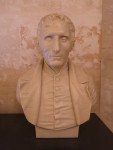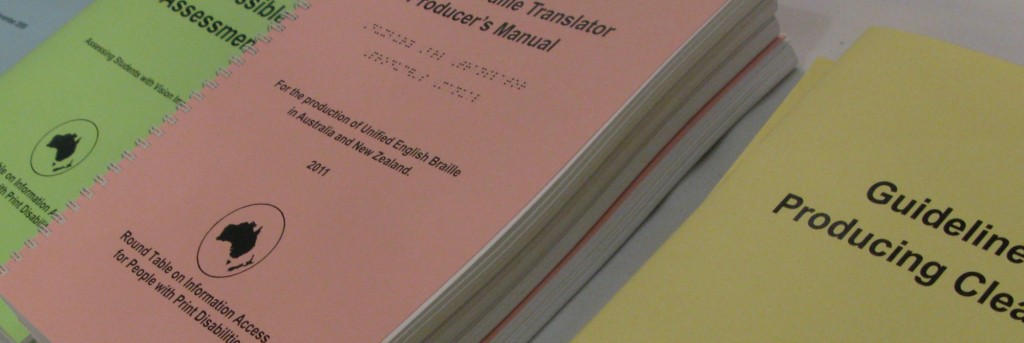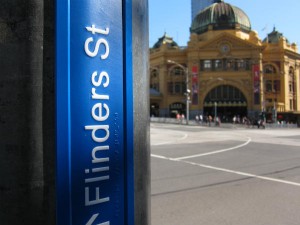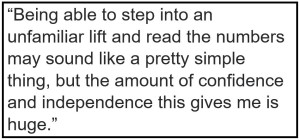Braille is the tactile system of reading and writing used by people who are blind or have low vision. Braille characters are composed of combinations of dots from a matrix of three rows and two columns:

As the pre-eminent system of touch reading for people who are blind or have low vision, braille is an essential tool for literacy. Enabling direct access to the written word, braille plays a vital role in many aspects of life, whether it be to label canned food or convey complex mathematical equations.
Braille was invented by Louis Braille (1809-1852). You can learn more about Louis Braille and the braille code here:

Louis Braille
- Louis Braille and the braille system – short article by Duxbury Systems
- Louis Braille, a Touch of Genius – biography by C. Michael Mellor available in print or braille
- Triumph over darkness: the life of Louis Braille – biography by Lennard Bickel
- How braille was invented – TedED video
- The braille alphabet – fact sheet (PDF)
Braille codes used in Australia
Unified English Braille is the official braille code for usage in Australia. It includes symbols and contractions for literary, mathematical and scientific text and can also be used to the representation of line drawings. Refer to the UEB page for information, documentation and resources relating to the Unified English Braille code.
Grade 1 (uncontracted) braille is used for signage in Australia. It is a one-to-one representation of letters without the use of contractions.
The braille code for music is a separate, international standard.
There is also a separate code for the representation of the International Phonetics Alphabet in braille, known as IPA braille.
Braille standards in Australia

The Australian Braille Authority works with the Round Table on Information Access for People with Print Disabilities to produce standards and guidelines for the provision of braille and tactile graphics in Australia. All of the following documents relating to braille and tactile graphics have been published by the Round Table and are available for free download.
- The Rules of Unified English Braille, Second Edition (2013)
- Unified English Braille: Australian Training Manual (2013)
- ABA Rules and Guidelines for Formatting Braille (2016)
- Duxbury Braille Translator Producer’s Manual for the Production of Unified English Braille in Australia and New Zealand (2011)
- Guidelines for Accessible Assessment (2011)
- Guidelines on Conveying Visual Information (2005)
The Guidelines for Technical Materials (2008) were produced by the International Council on English Braille.
Braille in other countries
World Braille Usage (2013) (pdf) is a comprehensive record of braille codes used throughout the world, covering 133 languages, 137 different braille alphabet and punctuation codes, and 142 countries.
Braille Fonts
To write uncontracted braille letters on a computer, you first need to download and install a braille font. These fonts can be used in Word or other applications. Note that simbraille fonts are often easier to read visually as a small placemarker is given for empty dots. It is recommended that the font size for braille should be a couple of points higher than for surrounding text.
Braille fonts will NOT give a correct translation from print to braille and should only be used by those without braille knowledge for the braille alphabet. For example, typing the number 1 on the keyboard will render braille dot 2, which represents the letters “ea” in the middle of a word or a comma at the end of a word. Those without a thorough knowledge of braille are advised to consult with a braille transcriber or proofreader. This ASCII Braille chart (pdf 117kb) lists the keyboard symbols and the resultant braille representation.
Braille activities and information for sighted children
Try using our braille alphabet chart to decode the secret message or braille writing template.
websites

photograph courtesy of the Feelix library
Braille Bug is a website for children from grades 3 to 6 to learn about braille, with information and interactive games, puzzles and activities.
Perkins resource packets about braille include information and games for younger and older children.
Braillealphabet.org provides free printable braille charts, worksheets and flashcards for sighted children to learn about braille.
Royal Blind national braille week activities include worksheets, games and flashcards to learn braille and have fun.
The Professional Development and Research Institute on Blindness offer printable fun sheets with activities, colouring pages, suggestions of braille games to make, and instructions for reading and writing braille by touch.
books
These print books feature braille and give an insight into blindness for young children.
- DK Braille Series: “Animals”, “On the Move”, “Shapes”, “It Can’t Be True!” and “Counting”
- “The Black Book of Colours” by Menena Cottin
- “Footsteps in the Fog” by Margaret Mahy
- “Louis Braille: The boy who invented books for the blind” by Margaret Davidson
- “Who was Louis Braille?” by Margaret Frith
- “Six dots: A story of young Louis Braille” by Jen Bryant
Braille and tactile signs

Braille and tactile signs must comply with the relevant provisions of the Disability Access to Premises (Buildings) Standards (2010), or, in cases where those Standards are not applicable, with the relevant provisions of Australian Standard AS1428.1-2009 (Design for Access and Mobility).
Signmakers should use grade one (uncontracted) braille and follow these physical specifications for braille. Please contact us for information on how your signs can be proofread for accuracy.
 Those looking for a braille signmaker may wish to consult our Directory of Braille Services and Products.
Those looking for a braille signmaker may wish to consult our Directory of Braille Services and Products.
Tactile Graphics
Tactile graphics, also known as raised line drawings, may accompany braille text.
 The Australian Braille Authority is a subcommittee of the Round Table on Information Access for People with a Print Disability Inc.
The Australian Braille Authority is a subcommittee of the Round Table on Information Access for People with a Print Disability Inc.
